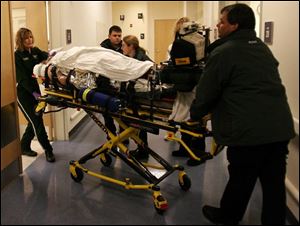
3 high level trauma sites better places for survival
1/26/2006
Personnel from Promedica Air wheel an accident victim into the emergency room at Toledo Hospital in West Toledo.
You ve got a better chance of surviving a serious accident if you re treated at a high-level trauma center such as the three level one trauma centers in Toledo instead of a smaller hospital, according to a national study released today.
While that may seem like an obvious finding, until now there s been little evidence to support that assumption, according to Ellen MacKenzie, lead author of the study appearing in the New England Journal of Medicine.
In the trauma community, everybody is quite excited about this study, said Ms. MacKenzie, a PhD statistician at Baltimore-based Johns Hopkins Bloomberg School of Public Health.
Other studies have suggested that trauma centers do make a difference [in survival], but there hadn t been any hard evidence supporting that.
There are three types of trauma centers.
A level one trauma center provides the highest level of care. Northwest Ohio has three level one centers: St. Vincent Mercy Medical Center, Toledo Hospital, and Medical University of Ohio Medical Center.
Level two centers have most of a level one s services.
St. Rita s Medical Center in Lima and Lima Memorial Hospital are the only level two centers in northwest Ohio.
Level three trauma centers have many of the services and equipment that level one and two centers do, but for seriously injured patients, their focus is to revive or stabilize patients, then send those patients to level one or two centers.
Level three centers in this region include Defiance Regional Medical Center, Flower Hospital in Sylvania, and St. Charles Mercy Hospital in Oregon.
Ms. MacKenzie and her colleagues studied how patients did at 69 hospitals, including 18 with level one trauma centers. The death rate at level one trauma centers was 7.6 percent versus 9.5 percent at regular hospitals.
A high-level trauma center, such as a level one center, must have a range of specialists available 24 hours a day who are able to quickly respond to emergency surgeries and other incidents.
Dr. Michael Oswanski, medical director of trauma services at Toledo Hospital, was glad to see the study s findings confirm what he and his colleagues have long believed. He said the study justifies an Ohio law passed in 2000 that requires all hospitals in the state to develop a system of making sure the most severely injured patients end up at trauma centers.
This study says you guys really have the right idea and Ohio is in the front-runner position on this, Dr. Oswanski said.
In addition, he said residents of northwest Ohio should feel fortunate to have so many trauma centers in this region.
In my view, the people of northwest Ohio are extremely well-served in terms of trauma care needs, he said. Not only do we have three level one trauma centers ... but it creates a situation where not only a patient injured in [downtown Toledo], but a patient injured in Fostoria or Findlay has direct and easy access to the level of care that fits their injury.
David Wellons, director of trauma and emergency services at St. Vincent Mercy Medical Center, said a regional trauma registry that many area hospitals submit data to shows northwest Ohio hospitals doing what the national study suggests: Referring severely injured patients to trauma centers.
This is pretty much what s already happening in our region, he said. Patients are getting to the right destination.
Contact Luke Shockman at: lshockman@theblade.com or 419-724-6084.